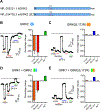Gain-of-function KCNJ6 Mutation in a Severe Hyperkinetic Movement Disorder Phenotype
- PMID: 29852244
- PMCID: PMC6679957
- DOI: 10.1016/j.neuroscience.2018.05.031
Gain-of-function KCNJ6 Mutation in a Severe Hyperkinetic Movement Disorder Phenotype
Abstract
Here, we describe a fourth case of a human with a de novo KCNJ6 (GIRK2) mutation, who presented with clinical findings of severe hyperkinetic movement disorder and developmental delay, similar to the Keppen-Lubinsky syndrome but without lipodystrophy. Whole-exome sequencing of the patient's DNA revealed a heterozygous de novo variant in the KCNJ6 (c.512T>G, p.Leu171Arg). We conducted in vitro functional studies to determine if this Leu-to-Arg mutation alters the function of GIRK2 channels. Heterologous expression of the mutant GIRK2 channel alone produced an aberrant basal inward current that lacked G protein activation, lost K+ selectivity and gained Ca2+ permeability. Notably, the inward current was inhibited by the Na+ channel blocker QX-314, similar to the previously reported weaver mutation in murine GIRK2. Expression of a tandem dimer containing GIRK1 and GIRK2(p.Leu171Arg) did not lead to any currents, suggesting heterotetramers are not functional. In neurons expressing p.Leu171Arg GIRK2 channels, these changes in channel properties would be expected to generate a sustained depolarization, instead of the normal G protein-gated inhibitory response, which could be mitigated by expression of other GIRK subunits. The identification of the p.Leu171Arg GIRK2 mutation potentially expands the Keppen-Lubinsky syndrome phenotype to include severe dystonia and ballismus. Our study suggests screening for dominant KCNJ6 mutations in the evaluation of patients with severe movement disorders, which could provide evidence to support a causal role of KCNJ6 in neurological channelopathies.
Keywords: K(IR)3; KCNJ6; channelopathy; inward rectifier; movement disorder; weaver mouse.
Copyright © 2018 IBRO. Published by Elsevier Ltd. All rights reserved.
Conflict of interest statement
Figures





Similar articles
-
Keppen-Lubinsky syndrome is caused by mutations in the inwardly rectifying K+ channel encoded by KCNJ6.Am J Hum Genet. 2015 Feb 5;96(2):295-300. doi: 10.1016/j.ajhg.2014.12.011. Epub 2015 Jan 22. Am J Hum Genet. 2015. PMID: 25620207 Free PMC article.
-
Expanding the spectrum of KCNJ6-related disorders: Milder phenotype with pathological startle responses.Clin Genet. 2023 Jan;103(1):103-108. doi: 10.1111/cge.14226. Epub 2022 Sep 15. Clin Genet. 2023. PMID: 36071510 Free PMC article.
-
Mutation analysis of the inwardly rectifying K(+) channels KCNJ6 (GIRK2) and KCNJ3 (GIRK1) in juvenile myoclonic epilepsy.Am J Med Genet. 2000 Feb 7;96(1):8-11. doi: 10.1002/(sici)1096-8628(20000207)96:1<8::aid-ajmg3>3.0.co;2-s. Am J Med Genet. 2000. PMID: 10686544
-
Phenomenology and clinical course of movement disorder in GNAO1 variants: Results from an analytical review.Parkinsonism Relat Disord. 2019 Apr;61:19-25. doi: 10.1016/j.parkreldis.2018.11.019. Epub 2018 Nov 16. Parkinsonism Relat Disord. 2019. PMID: 30642806 Review.
-
Enhanced GIRK2 channel signaling in Down syndrome: A feasible role in the development of abnormal nascent neural circuits.Front Genet. 2022 Sep 12;13:1006068. doi: 10.3389/fgene.2022.1006068. eCollection 2022. Front Genet. 2022. PMID: 36171878 Free PMC article. Review.
Cited by
-
Secondary biogenic amine deficiencies: genetic etiology, therapeutic interventions, and clinical effects.Neurogenetics. 2021 Oct;22(4):251-262. doi: 10.1007/s10048-021-00652-7. Epub 2021 Jul 2. Neurogenetics. 2021. PMID: 34213677
-
Comparison of K+ Channel Families.Handb Exp Pharmacol. 2021;267:1-49. doi: 10.1007/164_2021_460. Handb Exp Pharmacol. 2021. PMID: 34247281
-
GIRK2 Channels in Down Syndrome and Alzheimer's Disease.Curr Alzheimer Res. 2022;19(12):819-829. doi: 10.2174/1567205020666221223122110. Curr Alzheimer Res. 2022. PMID: 36567290
-
The scale of zebrafish pectoral fin buds is determined by intercellular K+ levels and consequent Ca2+-mediated signaling via retinoic acid regulation of Rcan2 and Kcnk5b.PLoS Biol. 2024 Mar 25;22(3):e3002565. doi: 10.1371/journal.pbio.3002565. eCollection 2024 Mar. PLoS Biol. 2024. PMID: 38527087 Free PMC article.
-
Polymorphisms of KCNJ6 Gene and Their Correlation with Immune Indicators in Yaks (Bos grunniens).Biomolecules. 2024 Dec 10;14(12):1576. doi: 10.3390/biom14121576. Biomolecules. 2024. PMID: 39766283 Free PMC article.
References
-
- Arnold K, Bordoli L, Kopp J, Schwede T (2006) The SWISS-MODEL workspace: a web-based environment for protein structure homology modelling. Bioinformatics 22:195–201. - PubMed
-
- Basel-Vanagaite L, Shaffer L, Chitayat D (2009) Keppen-Lubinsky syndrome: Expanding the phenotype. Am J Med Genet A 149A:1827–1829. - PubMed
Publication types
MeSH terms
Substances
Grants and funding
LinkOut - more resources
Full Text Sources
Other Literature Sources
Medical
Miscellaneous

